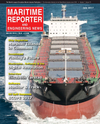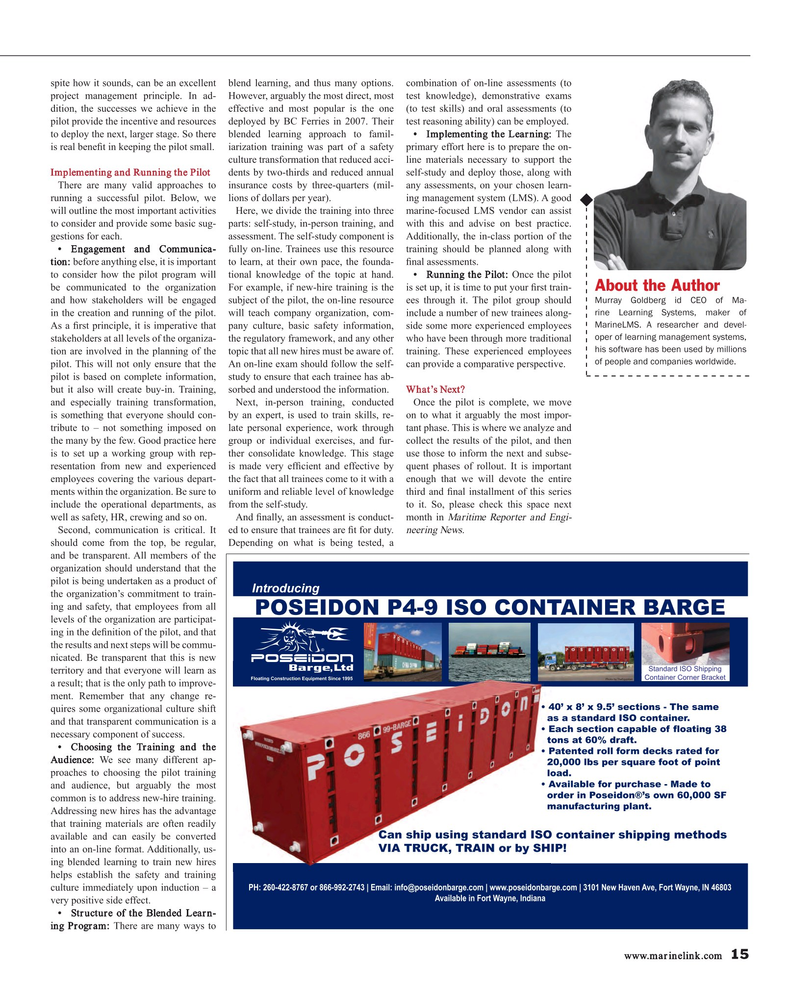
Page 15: of Maritime Reporter Magazine (July 2017)
The Marine Communications Edition
Read this page in Pdf, Flash or Html5 edition of July 2017 Maritime Reporter Magazine
spite how it sounds, can be an excellent blend learning, and thus many options. combination of on-line assessments (to project management principle. In ad- However, arguably the most direct, most test knowledge), demonstrative exams dition, the successes we achieve in the effective and most popular is the one (to test skills) and oral assessments (to pilot provide the incentive and resources deployed by BC Ferries in 2007. Their test reasoning ability) can be employed.
to deploy the next, larger stage. So there blended learning approach to famil- • Implementing the Learning: The is real bene? t in keeping the pilot small. iarization training was part of a safety primary effort here is to prepare the on- culture transformation that reduced acci- line materials necessary to support the
Implementing and Running the Pilot dents by two-thirds and reduced annual self-study and deploy those, along with
There are many valid approaches to insurance costs by three-quarters (mil- any assessments, on your chosen learn- running a successful pilot. Below, we lions of dollars per year). ing management system (LMS). A good will outline the most important activities Here, we divide the training into three marine-focused LMS vendor can assist to consider and provide some basic sug- parts: self-study, in-person training, and with this and advise on best practice. gestions for each. assessment. The self-study component is Additionally, the in-class portion of the • Engagement and Communica- fully on-line. Trainees use this resource training should be planned along with tion: before anything else, it is important to learn, at their own pace, the founda- ? nal assessments. to consider how the pilot program will tional knowledge of the topic at hand. • Running the Pilot: Once the pilot be communicated to the organization For example, if new-hire training is the is set up, it is time to put your ? rst train-
About the Author
Murray Goldberg id CEO of Ma- and how stakeholders will be engaged subject of the pilot, the on-line resource ees through it. The pilot group should rine Learning Systems, maker of in the creation and running of the pilot. will teach company organization, com- include a number of new trainees along-
MarineLMS. A researcher and devel-
As a ? rst principle, it is imperative that pany culture, basic safety information, side some more experienced employees oper of learning management systems, stakeholders at all levels of the organiza- the regulatory framework, and any other who have been through more traditional his software has been used by millions tion are involved in the planning of the topic that all new hires must be aware of. training. These experienced employees of people and companies worldwide.
pilot. This will not only ensure that the An on-line exam should follow the self- can provide a comparative perspective.
pilot is based on complete information, study to ensure that each trainee has ab- but it also will create buy-in. Training, sorbed and understood the information. What’s Next?
and especially training transformation, Next, in-person training, conducted Once the pilot is complete, we move is something that everyone should con- by an expert, is used to train skills, re- on to what it arguably the most impor- tribute to – not something imposed on late personal experience, work through tant phase. This is where we analyze and the many by the few. Good practice here group or individual exercises, and fur- collect the results of the pilot, and then is to set up a working group with rep- ther consolidate knowledge. This stage use those to inform the next and subse- resentation from new and experienced is made very ef? cient and effective by quent phases of rollout. It is important employees covering the various depart- the fact that all trainees come to it with a enough that we will devote the entire ments within the organization. Be sure to uniform and reliable level of knowledge third and ? nal installment of this series include the operational departments, as from the self-study. to it. So, please check this space next well as safety, HR, crewing and so on. And ? nally, an assessment is conduct- month in Maritime Reporter and Engi-
Second, communication is critical. It ed to ensure that trainees are ? t for duty. neering News.
should come from the top, be regular, Depending on what is being tested, a and be transparent. All members of the organization should understand that the pilot is being undertaken as a product of the organization’s commitment to train- ing and safety, that employees from all levels of the organization are participat- ing in the de? nition of the pilot, and that the results and next steps will be commu- nicated. Be transparent that this is new
Standard ISO Shipping territory and that everyone will learn as
Container Corner Bracket
Photo by Dave Gingrich Photo by TheEgyptian a result; that is the only path to improve- ment. Remember that any change re- quires some organizational culture shift and that transparent communication is a necessary component of success. • Choosing the Training and the
Audience: We see many different ap- proaches to choosing the pilot training and audience, but arguably the most common is to address new-hire training.
Addressing new hires has the advantage that training materials are often readily available and can easily be converted into an on-line format. Additionally, us- ing blended learning to train new hires helps establish the safety and training culture immediately upon induction – a very positive side effect. • Structure of the Blended Learn- ing Program: There are many ways to www.marinelink.com 15
MR #7 (10-17).indd 15 MR #7 (10-17).indd 15 7/6/2017 11:34:42 AM7/6/2017 11:34:42 AM

 14
14

 16
16
